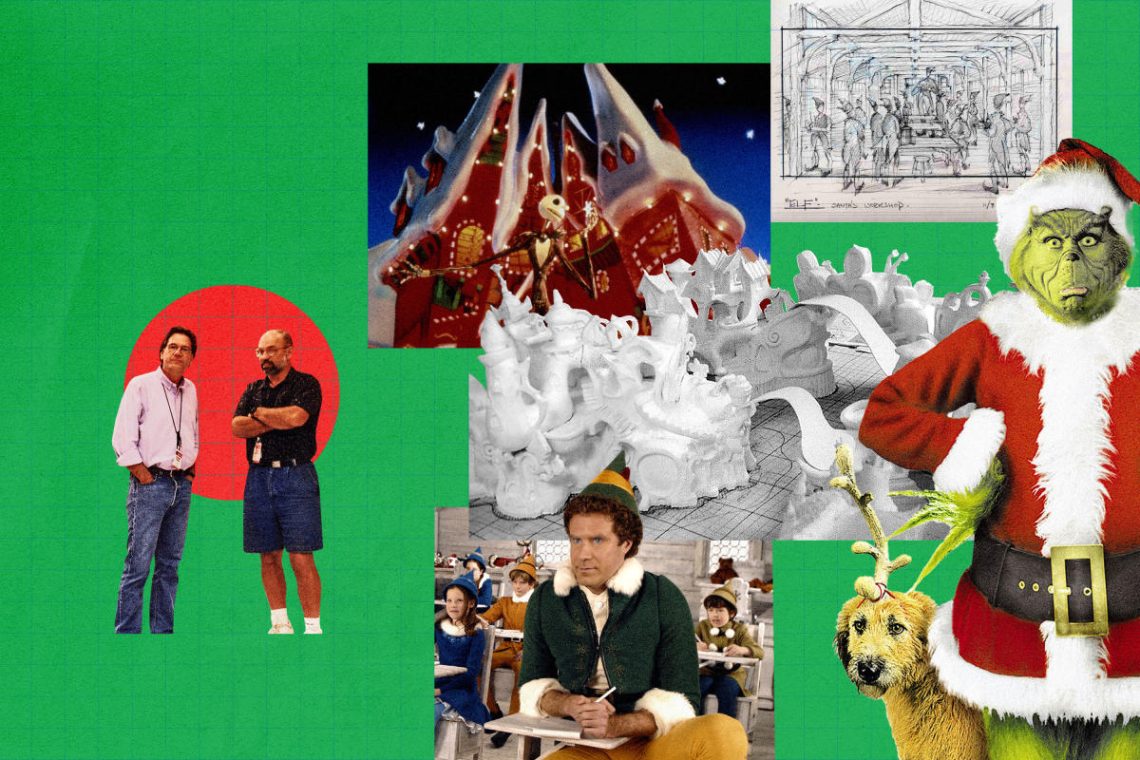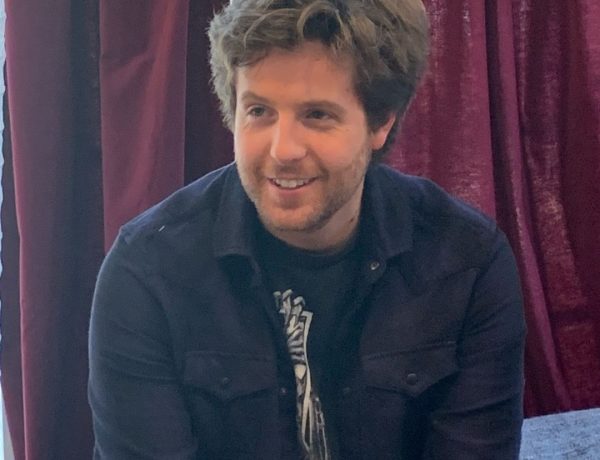Once upon a time in Hollywood, a team of production designers conjured some of the most unforgettable Christmas towns in film history — from the candy cane lanes in Elf and the Gothic towers of The Nightmare Before Christmas to the whimsical corners of Whoville in How the Grinch Stole Christmas.
Creating the overall look and style of a holiday classic is no easy feat, but as these designers tell Yahoo Entertainment, it all begins with an idea on a storyboard.
“It’s the most satisfying thing to be able to take a vision — be it from the director, the producer or a writer — and sort of give it life,” says Rusty Smith, the production designer for Elf. “Once you get it in the can, it’s always there. And it lives on.”
Getting there, however, can take months of “thoughtful, careful planning,” explains Michael Corenblith, the production designer for How the Grinch Stole Christmas. “Every dimension is examined from every angle, so by the time we get into the work, our concepts are pretty well-proven.”
Behind every designer is a devoted team with a shared passion for creating Christmas magic, but little is known about their process of bringing their respective Christmas towns to life. Here’s how they made it happen.
Oh, the places you’ll go!
Corenblith, whose résumé includes Apollo 13, Saving Mr. Banks, and Frost/Nixon, was hired by director Ron Howard to reimagine Whoville for his 2000 live-action remake starring Jim Carrey as the Grinch. He says he looked to the original source material for inspiration.
Published as a children’s book in 1957 by beloved author and illustrator Dr. Seuss, How the Grinch Stole Christmas had already been adapted an animated version for television in 1966. While Corenblith felt it was important to honor Dr. Seuss’s unique visuals, he knew it was just as vital to keep the world grounded in reality so that the Grinch’s “emotional journey towards redemption” would better hit home.
“Those emotions were only going to be fully expressed if our characters lived in fully dimensional, solid and tangible environments,” he explains. “We did not want to go down a road where the sets looked anything other than physical manifestations of real architecture.”
Corenblith spent weeks reviewing all 45 books written and illustrated by Dr. Seuss. He discovered that the author drew inspiration from medieval, Gothic, Greek revival and Parisian architecture when illustrating the whimsical buildings and columns that defined his style.
“I wanted Whoville to be like a very old European town that had existed since medieval times, and had grown across a long period of time but encompassed a variety of different architectural styles along the way,” he says.
That includes the post office building, inspired by the work of Spanish architect Antoni Gaudí, where the Grinch attempts to dishevel the townspeople’s mail; and the home of the “two old biddies” who raised the Grinch until his teens, for which Corenblith pulled inspiration from New Orleans architecture.
He also looked to Orson Welles’s Citizen Kane to paint a stark contrast between Whoville’s lively atmosphere and the Grinch’s gloomy cave on Mount Crumpit. “He was a lonely guy in a big space,” wandering through the giant halls alone, Corinblith explains. “That was one of the emotional metaphors I was trying to get across.”
The intense focus on detail paid off when Dr. Seuss’s widow, Audrey Geisel, visited the set with a group of film executives, lawyers and book publishers to give her official stamp of approval.
“She asked if the two of us could go behind the set and have a little chat,” recalls Corenblith, which he describes as “a moment that was fraught with peril.” What happened next surprised him. “She said, ‘I’m a little embarrassed to say that I can’t remember which book this particular building came from.’”
Corenblith says Geisel’s eyes lit up when he described the painstaking process of studying her late husband’s work. “That’s when I felt like we had accomplished what we set out to do,” he recalls. “His widow’s initial assumption from seeing the work was that this had come from Dr. Seuss’s hand.”
Twenty-three years later, the designer says it’s still one of the best compliments he’s ever received: “It’s something you never really forget.”
Making Christmas
While Tim Burton’s The Nightmare Before Christmas wasn’t the first film to utilize stop-motion animation, the 1993 hit marked a significant milestone in the technique and would come to define Burton’s campy, Gothic style.
Much of the production had been set in motion by Kendal Cronkhite before Deane Taylor came on board. As Taylor remembers it, he and Cronkhite were particularly inspired by vintage European Christmas cards. Along with director Henry Selick and head of story Joe Ranft, the small and mighty team knew they were making history.
“This [film] was like nothing else and everybody knew it,” explains Taylor. “This is not to say there was no friction. As the shots built up in the can, the competition grew exponentially. Egos did clash, but dissolved under the want to achieve a common goal.”
As seen in the film, Jack Skellington, the Pumpkin King of Halloween Town, becomes enchanted by the Christmas spirit after discovering a hidden door leading to Christmas Town. He takes over the holiday by putting his own twist on it, but his well-intentioned attempts ultimately lead to chaos.
“There was nothing to measure the look against. It could stand alone if need be,” he recalls thinking at the time. Taylor says Burton was so busy directing Batman Returns at the time that “his response time was limited,” which allowed Taylor’s creativity to flourish.
“I was told if we didn’t hear anything [from Burton], we could take that as an approval,” he explains. “We took this as a positive direction and went about the business of creating quarter-scale models assembled from foam core and hot glue. This gave us a lot of freedom. We were able to use the storyboards as a guide and literally build the shot.”
Selick’s direction was “crystal clear and unforgiving,” says Taylor. “You did your best and nothing less.”
It was serious business, and their work would change the course of Hollywood animation forever. The impact resonates 30 years later, and while Taylor isn’t thrilled about seeing their characters plastered onto merchandise — socks, underwear, hoodies, and even tattoos — he admits to having a “warm, fuzzy feeling” knowing that they’re so beloved.
“These are Tim’s babies, we just delivered them,” he says.
‘My job is to make dreams come true’
Buddy the Elf has become one of the most recognizable faces of the holiday season.
The 2003 film’s production designer, Rusty Smith, whose work you may know from Get Out, Meet the Parents and A Christmas Story Christmas, says the project is a love letter to New York City.
Elf was shot in New York City one year after the 9/11 attacks, and months before the holiday season would begin. “We brought Christmas to a lot of areas that didn’t have it already,” which helped reinvigorate the city, he recalls.
Director Jon Favreau wanted New York City to be a backdrop in the film. After shooting in Manhattan for two weeks straight, Smith said the team went “renegade” on the last day, spontaneously shooting on the streets without proper permits, in hopes of getting a candid shot that perfectly represented the city. It worked.
“They took Will out on the streets in the costume and they did crazy stuff,” he remembers. At one point, Ferrell improvised hilarious moments with pedestrians, including a man dressed as Santa. “That’s the stuff that made it into the movie,” Smith says.
The North Pole was a different story. Drawing inspiration from the 1960s animated TV specials Frosty the Snowman and Rudolph the Red-Nosed Reindeer, with added elements of Scandinavian folklore, Smith used the color white to create a contrast between fantasy and reality.
“The backgrounds were all white and the puppets were all in color, so they popped out,” he explains of the two specials. “Similarly, I tried to make white a theme throughout Elf — the inside office of the New York Times is white and [Buddy’s] apartment was white, for example.”
Adjusting for size was another issue. Buddy as an adult man is often stacked next to elves, who are short in stature. To compensate, Smith and his team came up with their own language: “Elf Size” and “Buddy Size.”
“Buddy’s size was two-thirds, or 75%, of what the elves would be,” he explains. “If the elves were in the human world, it had to be 150% sized.” The proportions worked when it came time to filming actors.
“[Favreau] wanted the in-camera forced perspective,” he says. The visual effects technique creates the illusion of an object appearing larger or smaller than they are, which was done by spatial arrangement (positioning an actor closer to the camera than an object) to make the illusion, as well as creative camera angles.
That made for comedy gold. Buddy’s awareness of what constitutes a normal size is made clear by two memorable scenes inside Gimbels department store.
The scene in which Buddy turns the store into a winter wonderland overnight, hanging paper snowflakes on the ceilings, was an uphill battle until the very end. “The art department worked for weeks on the paper things,” he says. “They were draped all over the art department, I mean, it was intense!”
Another scene featured Caan’s character as he destroys a giant Lego display of the New York City skyline. When Favreau came up with the idea, Smith had less than two weeks to build the display. Fortunately, the Lego company stepped in to help.
“We had a whole team of people make a fully assembled version, and then a sort of broken version,” he said. “It had to be done in one take, and [when it wrapped] it was a huge event.”
Smith looks back at that time with admiration. “It was so much fun, and it was exhausting,” he says, adding that being a production designer is a calling as much as it is a skill.
“My job is to make dreams come true,” he says. “It’s the challenge that keeps me alive.”




